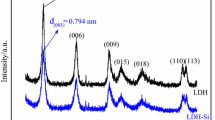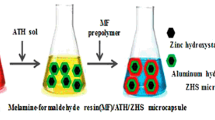Abstract
This paper mainly studies synergistic flame-retardant effects and smoke suppression properties of mesoporous silica-LDHs system on the ethylene-vinyl acetate copolymer (EVA). The mesoporous silica-LDHs/EVA composites were prepared based on EVA as resin matrix, mesoporous silica-LDHs as flame-retardant composites. The flame-retardant and thermal degradation properties of the composites were characterized by limiting oxygen index (LOI), cone calorimeter test, scanning smoke density test (SDT), electronic microscopy (SEM) and thermogravimetry–Fourier transform infrared spectrometry (TG-IR) analysis. Remarkably, addition of certain amount of mesoporous silica-LDHs could evidently increase LOI values. The heat release rate and the total heat release of the composites were much lower than of pure EVA. The SDT results showed that the composites containing mesoporous silica-LDHs produced less smoke than pure EVA for a period of time. The morphologies and structures of the residues, revealed by SEM, ascertained that the formed char layers on the composites were denser than that of the LDHs/EVA composites. Mesoporous silica in the material can help smoke suppression. TG-IR data reveal that the incorporation of mesoporous silica-LDHs promoted the release of H2O, and CO2, meanwhile reduced harmful gases release.















Similar content being viewed by others
References
Setyawan H, Yuwana M, Balgis R. PEG-templated mesoporous silicas using silicate precursor and their applications in desiccant dehumidification cooling systems. Microporous Mesoporous Mat. 2015;218:95–100.
Hao N, Tang F, Li L. MCM-41 mesoporous silica sheet with ordered perpendicular nanochannels for protein delivery and the assembly of Ag nanoparticles in catalytic applications. Microporous Mesoporous Mat. 2015;218:223–7.
Huang W, Yu X, Tang J, Zhu Y, Zhang Y, Li D. Enhanced adsorption of phosphate by flower-like mesoporous silica spheres loaded with lanthanum. Microporous Mesoporous Mat. 2015;217:225–32.
Wang H, Zhang SF, Liu JW, Ouyang LZ, Zhu M. Enhanced dehydrogenation of nanoscale MgH2 confined by ordered mesoporous silica. Mater Chem Phys. 2012;136(1):146–50.
Park S, Bang J, Choi J. 3-Dimensionally disordered mesoporous silica (DMS)-containing mixed matrix membranes for CO2 and non-CO2 greenhouse gas separations. Sep Purif Technol. 2014;136:286–95.
Marcoux L, Florek J, Kleitz F. Critical assessment of the base catalysis properties of amino-functionalized mesoporous polymer-SBA-15 nanocomposites. Appl Catal A Gen. 2015;504:493–503.
Brunella V, Jadhav SA, Miletto I, Berlier G, Ugazio E, Sapino S. Hybrid drug carriers with temperature-controlled on–off release: a simple and reliable synthesis of PNIPAM-functionalized mesoporous silica nanoparticles. React Funct Polym. 2016;98:31–7.
Edenharter A, Breu J. Applying the flame retardant LDH as a Trojan horse for molecular flame retardants. Appl Clay Sci. 2015;114:603–8.
Li C, Wei M, Evans DG, Duan X. Recent advances for layered double hydroxides (LDHs) materials as catalysts applied in green aqueous media. Catal Today. 2015;247:163–9.
Gao Y, Wang Q, Wang J, Huang L, Yan X, Zhang X. Synthesis of highly efficient flame retardant high-density polyethylene nanocomposites with inorgano-layered double hydroxides as nanofiller using solvent mixing method. ACS Appl Mater Interface. 2014;6(7):5094–104.
Chen Y, Zou H, Liang M, Cao Y. Melting and crystallization behavior of partially miscible high density polyethylene/ethylene vinyl acetate copolymer (HDPE/EVA) blends. Thermochim Acta. 2014;586:1–8.
Sonia A, Dasan KP. Celluloses microfibers (CMF)/poly (ethylene-co-vinyl acetate)(EVA) composites for food packaging applications: a study based on barrier and biodegradation behavior. J Food Eng. 2013;118(1):78–89.
Rahman IA, Padavettan V. Synthesis of silica nanoparticles by sol-gel: size-dependent properties, surface modification, and applications in silica-polymer nanocomposites—a review. J Nanomater. 2012;11:8–22.
Ma J, Ding J, Li L, Zou J, Kong Y, Komarneni S. In situ reduction for synthesis of nano-sized Cu2O particles on MgCuAl-LDH layers for degradation of orange II under visible light. Ceram Int. 2015;41(2):3191–6.
Prasanna SV, Kamath PV. Synthesis and characterization of arsenate-intercalated layered double hydroxides (LDHs): prospects for arsenic mineralization. J Colloid Interface Sci. 2009;331(2):439–45.
Tseng CH, Hsueh HB, Chen CY. Effect of reactive layered double hydroxides on the thermal and mechanical properties of LDHs/epoxy nanocomposites. Compos Sci Technol. 2007;67(11):2350–62.
Li L, Qian Y, Jiao CM. Synergistic flame retardant effect of melamine in ethylene–vinyl acetate/layered double hydroxides composites. J Therm Anal Calorim. 2013;114(1):45–55.
Liu J, Zhang Y, Peng S, Pan B, Lu C, Liu H. Fire property and charring behavior of high impact polystyrene containing expandable graphite and microencapsulated red phosphorus. Polym Degrad Stab. 2015;121:261–70.
Yi J, Yin H, Cai X. Effects of common synergistic agents on intumescent flame retardant polypropylene with a novel charring agent. J Therm Anal Calorim. 2013;111(1):725–34.
Wang J, Qian L, Xu B, Xi W, Liu X. Synthesis and characterization of aluminum poly-hexamethylenephosphinate and its flame-retardant application in epoxy resin. Polym Degrad Stab. 2015;122:8–17.
Jia CX, Chen XL, Qian Y. Synergistic flame retardant effect of graphite powder in EVA/LDH composites. Plast Rubber Compos. 2014;43(2):46–53.
Xu MJ, Xu GR, Leng Y, Li B. Synthesis of a novel flame retardant based on cyclotriphosphazene and DOPO groups and its application in epoxy resins. Polym Degrad Stab. 2016;123:105–14.
Qian Y, Wei P, Jiang P, Li Z, Yan Y, Ji K. Aluminated mesoporous silica as novel high-effective flame retardant in polylactide. Compos Sci Technol. 2013;82:1–7.
Liu L, Hu J, Zhuo J, Jiao C, Chen X, Li S. Synergistic flame retardant effects between hollow glass microspheres and magnesium hydroxide in ethylene-vinyl acetate composites. Polym Degrad Stab. 2014;104:87–94.
Chen X, Jiang Y, Jiao C. Smoke suppression properties of ferrite yellow on flame retardant thermoplastic polyurethane based on ammonium polyphosphate. J Hazard Mater. 2014;266:114–21.
Hu W, Yu B, Jiang SD, Song L, Hu Y. Hyper-branched polymer grafting graphene oxide as an effective flame retardant and smoke suppressant for polystyrene. J Hazard Mater. 2015;300:58–66.
Li L, Qian Y, Jiao CM. Influence of red phosphorus on the flame-retardant properties of ethylene vinyl acetate/layered double hydroxides composites. Iran Polym J. 2012;21(9):557–68.
Hirose S, Kobashigawa K, Izuta Y, Hatakeyama H. Thermal degradation of polyurethanes containing lignin studied by TG-FTIR. Polym Int. 1998;47(3):247–56.
Salgado J, Paz-Andrade MI. The effect of firesorb as a fire retardant on the thermal properties of a heated soil. J Therm Anal Calorim. 2009;95(3):837–42.
Zhao CX, Liu Y, Wang DY, Wang YZ. Synergistic effect of ammonium polyphosphate and layered double hydroxide on flame retardant properties of poly(vinyl alcohol). Polym Degrad Stab. 2008;93(7):1323–31.
Zanetti M, Kashiwagi T, Falqui L, Camino G. Cone calorimeter combustion and gasification studies of polymer layered silicate nanocomposites. Chem Mater. 2002;14(2):881–7.
Weil ED, Patel NG. Iron compounds in non-halogen flame-retardant polyamide systems. Polym Degrad Stab. 2003;82(2):291–6.
Gregoriou VG, Kandilioti G, Bollas ST. Chain conformational transformations in syndiotactic polypropylene/layered silicate nanocomposites during mechanical elongation and thermal treatment. Polymer. 2005;46(25):11340–50.
Chen YJ, Zhan J, Zhang P, Nie SB, Lu HD, Song L, Hu Y. Preparation of intumescent flame retardant poly(butylene succinate) using fumed silica as synergistic agent. Ind Eng Chem Res. 2010;49(17):8200–8.
Acknowledgements
The authors gratefully acknowledge the National Natural Science Foundation of China (Grant No. 51372129), the National Natural Science Foundation of China (Grant No. 51572138) and the Projects of Science and Technology from Shandong Province (Grant No. 2013GSF11608).
Author information
Authors and Affiliations
Corresponding author
Rights and permissions
About this article
Cite this article
Qian, Y., Li, S. & Chen, X. Preparation of mesoporous silica-LDHs system and its coordinated flame-retardant effect on EVA. J Therm Anal Calorim 130, 2055–2067 (2017). https://doi.org/10.1007/s10973-017-6508-9
Received:
Accepted:
Published:
Issue Date:
DOI: https://doi.org/10.1007/s10973-017-6508-9




